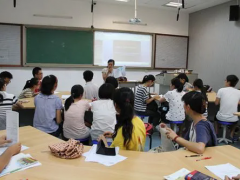初中英语教学设计范文
初中英语教案范文
课题 Im Lost Part 1 Listening and Speaking教学目标 Language: past continuous tense. Ability: talking about accidents, describing a continuous event in the past. Emotion: make students care about safety.重点 the past continuous tense难点 describing accidents 突破方法 practice教学方式 pair work computer板书设计 The Fire fall stair accident ambulance at the crossing 教师活动 学生活动 设计意图教学过程 Step 1 Warm-upShow the students a picture.Question: What are they doing?(The woman is asking for the way and the man is giving the way.)Step 2 Lead in If we want to talk about the location of the places, we can use the prepositions. Can you tell me some prepositions you know?(in front of , behind, next to……) think answerlook say 通过图通过简单的问题复习已学知识,巩固动词的过去时态。
通过对图片的描述激活学生的背景知识,为听力理解做准备。教学过程 Show another picture, have a revision of the prepositions and learn some new ones. between next to in front of behind to the left/right of opposite to Ask and answer questions :Where is the hotel?Its between the post office and the park.Step3 Listening 1. Students listen to a short interview and then match the person with the correct place and action.Listen to a comparatively long dialogue. Students work in pairs and translate the six sentences. Then after listening, they shoulddecide the sentences true or false. Listen to a piece of news. For the first time, students should find out the when and where did it happen. For the second time, they should fill in the blanks.Step 4 Dialogue Show students three pictures. They work in pairs, practicing ask and answer questions to describe the pictures according to the given phrases.Step 5 Homeworknew wordsactivity booklisten matchlisten judgelisten find fillask answer 帮助学生进入听力材料的主题,为后面的练习做准备。
培养学生泛听和精听的能力通过对本节课的表达方式的学习,练习学生的说的能力。巩固课堂内容。
初中英语教学方法
一、激趣法 教学心理学告诉我们,只有学生感兴趣的东西,学生才会积极地开动脑筋认真思考.当学生初学英语时,兴趣都很浓厚.但随着学习难度的增加,逐渐遇到一些困难,如单词记不住,语音、语调掌握不准等,就会产生畏难情绪,学习成绩也随之降低.在这个关键时期,教师要帮助学生在认知领域里学会动脑,传授可供思考的知识,避免死记硬背.比如在引导学生读、记单词时,就教给拼读规则.继续采用新奇而具"刺激"的教学手段,以帮助学生维持兴趣.如此不断努力,学生的学习兴趣才会更大、更持久.激趣法通常采用的是教学游戏法. 游戏是激发、保持学生兴趣的手段,它使英语教学寓教于乐,学生学得轻松、自然,必然乐于学.游戏法是一种积极的教学形式,能够培养学生的思维能力,是教授学习方法的有效途径.它具备知识性、科学性、趣味性和竞争性等特征.从内容分可分为词汇教学和语法教学;从活动形式来看,教学游戏涉及听、说、读、写,老师应从实际出发科学地设计各种游戏,力求惟妙惟肖地模拟日常人们喜闻乐见的活动,使学生积极参与. 1.词汇教学游戏 找替身----教师先写一个学过的单词,让学生找一个字母当"替身",替换该词某一字母,使之形成本课的生词.如生语:soon可根据学过的单词noon,要求改写字母n为s .boat-coat;fun-fan;cake-coke.还可借题发挥替换其它字母,达到复现更多词汇的目的,如:seat meat meat 交朋友----一个词或一个词缀可以与某一个词结成"朋友",构成复合词或派生词.教师指定一个词或词缀,让学生帮助该词或词缀交"朋友",交的"朋友"越多越好.如day-today-Sunday-Saturday; ear-clear-dear-near-hear-tear-year 掐头换尾.教师可以先写一个词,让学生将该词第一个字母去掉,然后在词尾加或换一个或两个字母,使其成为一个新词.还可将新组成的单词进行第一组游戏.如:ride-idea-dear- early;other-there-these-those 2.语法教学游戏.语法教学是学生用词或组句的关键,也是英语学习较难理解的重点.在语法教学中,教师应善于诱导学生充分发挥自己的想象能力,引导学生对较为难记的语法知识点采取最为简明的方法记忆.如采用排词成句、发挥想象、广告效果等,都可取得良好效果.期刊文章分类查询,尽在期刊图书馆 二、创设情境法 任何人的学习活动总是在特定的背景中进入学习状态的.这个背景就是学习者和周围的环境、人群之间的关系.初中生年龄小,活泼好动,影响他们进入学习状态的因素更是多种多样.因此,教师要在课堂教学中注意创设情景,创设语境,吸引学生很快进入学习状态,同时保证他们在课堂上始终保持昂扬、奋发、进取的心理状态.创设情境法主要做法有: 1.建立课前3分钟用英语做值日报告制度,使学生牢固掌握每一课的Everyday Sentences.培养学生单独用英语讲一段话,如每日见闻,谈所熟悉的人,爱好、景色等.一般可先安排口语较好的学生,给其他学生树立榜样.对于稍差的学生,在课前把任务布置好,帮助他们做好准备,以致能在课堂上表现得很出色.使学生感到只要努力就可以取得成绩,感到自己正在不断进步,有所收获. 2.在课堂教学中大量使用英语,让学生置身于英语的语境之中.利用实际生活情景,表演情景,模拟交际情景,直观教具创设情景等形式,帮助学生听懂英语,进而理解枯燥的单词、乏味的句型.具体可采用: (1)利用现行教材大量对话式内容,由学生们表演.把程度不同的学生组合成一组,对白多的角色由较好的学生扮演,对白少的角色由差生扮演,这样促使同学之间在准备过程中,相互帮助,团结协作,学生们寓语言训练于愉乐之中,巩固了所学的知识,口语表达能力得到锻炼. (2)复述是口语训练的重要形式,能够提高学生综合运用语言知识的能力.可以用不同的人称、时态、语态来表达所学的内容.老师可以按着故事的情节为线索,把重点词句投影到黑板上,或以时间顺序,类别等为线索画成表格,引导学生复述.这样做,学生们在复述时有章可循,不会感到吃力,避免死记硬背.也可以用简明、易画、生动的简笔画.老师可以边画边引导学生叙述,语言和画面结合起来,创造语言环境、帮助学生理解记忆,有利于增强学生的表达能力. (3)模仿课文中的部分段落来表达周围所熟悉的人或事.这种训练基于背颂部分段落之后进行的训练.背颂范文是我国传统的学习方法,运用于英语教学,同样可以起到积累语言精华的作用,有助于指导语言实践. 3.每节课尾留出3分钟,让学生用英语练"说".其内容是新学过的知识,目的是复习、巩固本节科所学知识;其形式是或看图说话,或自由会话或叙述某事某物. 三、活动育智法 活动的目的是巩固、扩充知识,发展思维、培养能力.首先,教师要通览全学段英语教材,精研课文,然后,根据大纲要求和教材的知识体系和能力训练体系,分单元设计活动内容、活动形式.如,练唱英语歌曲;猜谜语;背诵小诗;模拟会话;讲述内容简单的小故事;角色扮演,等等.这些活动多放在课内进行.有些活动还可放在课外进行.如开辟"每周10题"的英语学习专栏,选出与课文内容相关的练习题或短文,供学生自学,以巩固新知,拓展知识视野. 。
谁能给我一个全英文的初中优秀教案范文 要全英的 规范的教案
Teaching Plan Be Careful with Numbers in Listening Class: Class 12, Senior Two Date: May 16,2007 Teacher: Ni Yazhen School: Zhi Yuan Senior High School Teaching Material: P75 S2B Oxford English; Additional material(The new Star Wars movie, Be Careful with Numbers) Teaching Objectives: Knowledge objectives: To enable students to listen and complete some exercises Ability Objectives: To encourage the students to have basic skills of listening. Emotion objectives: To cultivate the cooperation through peer interaction Teaching aids: Multi-media Teaching and learning method: Guiding for learning Teaching Procedures: I. Presentation Today well have a class on listening practice “Be careful with numbers in listening”: First well play a game. Then, well practice. Lead-in A game on number II. Performance: Quick and accurate response to numbers is very important in daily communication. Telephone numbers, addresses, prices, temperatures, time and dates all closely linked with the use of numbers .Besides, numbers also play a very important part in broadcast programmes such as reports Now lets listen to some advice from experts. Task 1 Be Careful with Numbers (Play the recorder Twice) Individual work→pair work(check the answer with your partner)→Group work(Underline the important sentences. e.g. The differences between million and billion, “-teens” and “-tys” are ….. “Seventeen point five million.”…)Whole class read the key sentences. Well-done! Numbers are all around us. Let us practice with numbers and learn to be good at numbers.(First read out the following numbers… Watch the screen) Task 2 Listen to some statements about the brief history of films and TV. First check the answers in groups. If you have different opinion , please raise your hands. Judgement: (First students give themselves a judge. Then teacher does it) It seems no challenge. Now, Well do challenge exercise. So pay special attention to the numbers in the passage and select the correct answer from the choices listed below. First teach the students new words in listening material. Then ask students to read out the numbers in Star Wars. III. Promotion: Challenge exercise Star Wars Listen to the tape twice →Check the answers IV. Conclusion: What we learned today is “Be careful with numbers in numbers.” Remember the following points when you are doing listening tasks: 1. Take great care with the spelling of names and with addresses and phones numbers, prices, time and dates。
2. To find the right answer, you may need to do simple calculations or combine two sets of data. 3. Listen carefully for words and phrases such as these: half / twice as expensive as… its shorter / cheaper / quicker than… the lightest / heaviest / newest not as long / cheap / good as… Some useful abbreviations and symbols for note taking( See PPt.) V. Assignment: 1.Review P6-7 –Filling in forms P43– Working with numbers 2.Collect some information on listening skills Teaching Plan Be Careful with Numbers in Listening Class: Class 12, Senior Two Date: May 16,2007 Teacher: Ni Yazhen School: Zhi Yuan Senior High School Teaching Material: P75 S2B Oxford English; Additional material(The new Star Wars movie, Be Careful with Numbers) Teaching Objectives: Knowledge objectives: To enable students to listen and complete some exercises Ability Objectives: To encourage the students to have basic skills of listening. Emotion objectives: To cultivate the cooperation through peer interaction Teaching aids: Multi-media Teaching and learning method: Guiding for learning Teaching Procedures: I. Presentation Today well have a class on listening practice “Be careful with numbers in listening”: First well play a game. Then, well practice. Lead-in A game on number II. Performance: Quick and accurate response to numbers is very important in daily communication. Telephone numbers, addresses, prices, temperatures, time and dates all closely linked with the use of numbers .Besides, numbers also play a very important part in broadcast programmes such as reports Now lets listen to some advice from experts. Task 1 Be Careful with Numbers (Play the recorder Twice) Individual work→pair work(check the answer with your partner)→Group work(Underline the important sentences. e.g. The differences between million and billion, “-teens” and “-tys” are ….. “Seventeen point five million.”…)Whole class read the key sentences. Well-done! Numbers are all around us. Let us practice with numbers and learn to be good at numbers.(First read out 。
初中英语听说课教学设计需要注意哪几个方面
一、听说课前准备应该注意的几个方面:听前活动设计的目的是引导学生进入主题听力状态,为更好地听做各方面的准备.内容包括让学生明确听力学习的目标任务,对听力材料的内容引起注意,提起兴趣,以最佳状态进入听力活动.准确把握听前活动的设计,结合学生实际,设计既贴近学生生活实际,又满足听力准备的需求.引起学生的学习兴趣、调动学生的学习积极性.那么听说课准备应该注意什么呢? 1、听前活动设计不应包括词汇扩展听前活动的目的是为听力活动的开展做必要的准备,扫清会对听力理解产生障碍的词汇及必要的背景知识准备是必不可少的.但是这项准备工作只是要学生认知生词即可,词汇的扩展学习应放在听力理解之后,这样能使教学层次清楚,又重点突出. 2、听前活动内容设计要融入对新语言知识的感知通过听前活动使学生感知听力课文中出现的新语言知识如核心词汇句型,这样不仅能降低听力理解的难度,还能增加新知识学习的层次与复现率,使学习过程更系统、更扎实. 3、听前活动所占时间不宜过长,且内容紧扣听力材料. 二、听说课选用听力材料应该注意的几个方面:1、准确定位所选材料的主题内容 听说课教学设计前要对听力课文进行研究和分析.教师要搞清楚本听力语料的主题内容及所承载的重点语言知识,分析教学的重点和难点,在此基础上确定教学目标. 2、准确定位听力材料的教学重点和难点 分析听力课文的另一个目的是定位教学的重点和难点.一篇听力语料的教学重点与难点的确定不只是根据听力语料确定,而要建立在分析学情的基础上,要根据学生的实际水平、认知特点和需求确定教学重点和难点.教师不能绕着难点走,学生只有在一个学段中突破一些听力难点,学生的听能才有所发展. 3、教材中任务活动的分析和有效使用各个版本教材都围绕听力课文设计了各种练习任务,为教师的教学设计提供了大量可用的练习活动资源.教师要根据自己学生的特点,分析和选择性地使用这些练习.教师要全面、整体分析教材中围绕听力课文所设计的活动,明晰每一项活动要到达的目的,选择使用适宜的活动及活动的顺序,并要设计如何开展活动.而活动开展的过程应是培养听力策略的过程,教师要注意培养学生有效开展听力活动的策略及完成听力任务的策略. 三、听说课教学目标设计应该注意:听说课的教学目标的合理设计是成功教学的保障.教学目标制定要明确、具体、全面.听说课的教学目标一定要有听力理解技能提高目标、语言知识感知、学习、运用目标、主题口语能力提高目标.同时要兼顾情感态度、学习策略、文化意识的渗透. 四、听说课教学过程中设计需要注意的问题1、听力理解活动要充分在教学设计中要注重学生听力理解技能的培养和训练,应将教学重点放在听力和口语能力的提高上.应该把声音与图画或实物等配合帮助学生理解听力材料的内容.可减低难度,使教学情景化,增加趣味性.要根据听力内容的需要,学生语言知识和技能的发展需要设计听力活动.让学生按要求完成某种任务,如做笔记、填写表格、写摘要、进行实际操作.泛听和精听相结合是提高听力水平的重要措施,泛听、精听相结合,不能机械地完成教材中设置的听力活动,应对听力活动的难易程度是否适宜自己的学生,是否能帮助学生真正理解听力内容进行分析和思考. 2、避免先看录音原文,再听录音 3、不要一边听一边看听力原文五、听力材料中的生词处理需要注意的几个方面:认知生词应该是听力之前的准备活动之一,目的是要帮助学生扫除一些听力障碍. 1. 对生词要进行分析,分层次处理.不提倡在听力活动前将所有生词都挑出来进行认知.这样做,能使学生在听力活动中精神更集中. 2. 根据学生情况如果学生能够通过上、下文猜出来的词,听前就不要处理这个生词,作为训练学生猜词能力的练习材料, 同时使听力材料也增加了一定的难度. 3. 重点生词的操练和运用应放在听力活动之后进.六、听后活动设计中应注意的几个问题1、语言结构操练应尽量做到全员参与主题性口语输出能力是建立在对相关词汇及句式的掌握上.词汇和句式要做到能上口,必须要经历一个操练的过程.这些基础内容应是每个学生都要掌握的. 2、语言知识训练形式要重语言交际教师的课上训练形式要侧重于学生的交际能力培养.笔头练习活动要与口头活动结合起来.但是有些教师设计的听后活动都是笔头活动,这就不符合听说课的原则,教师一定要认识到要发展学生在现实生活中运用语言的能力只靠“笔头活动”是不能实现的. 要靠听说读写多种活动来逐步培养的. 3、语言交际活动设计要符合真实交际任务的需要很多教师能够就听力主题设计口语交际活动,但是到了听后活动的最后一个环节还出让全体学生看着黑板上的词汇、句型,这样设计的依据是学生没有这些支撑无法开展口语交际活动.然而课程总目标是要学生在今后的现实生活中的真实情景中成功地进行交际,教师要尽量鼓励中等以上的学生不看黑板,进行口头交流,以真正提高他们在真实语境中用英语进行交际的能力. 七、听说课的时间分配设计应该注意:一节课的时间极其宝贵、有限.教学设计中每个环节的时间安排与使用效率是值。
初中英语教案范文
八年级下英语Unit6 Section A(1a-2c) 第一课时
学习目标;1.掌握本课的单词
2.能用新句型进行对话,了解完成时态的用法。
3.培养学生们的交际能力,以及相互帮助和合作的能力。
学习重点; 1.现在完成时态的构成及用法,标志词.
2.have /has been and have/has gone 的区别.
预习任务;
任务一:自主完成以下词汇
收集___________ 贝壳____________ 一双 __________ 溜冰鞋 ________ 自从____________-
马拉松赛跑 ___________ 一双溜冰鞋 ___________在马拉松赛中_______________
任务二:自主预习1b,2a,2b的听力
1;译一下的句子Ive been skating for five hours.
I skated for four hours.
2;以上两个句子有什么区别_________________
3;拓展练习
a. 自从八点开始,我就已经滑冰了。____ ______________________
b. 我读过这本书._________________
c. 我收集贝壳已经两年了。_________________________________
4;自主区别for /since用于现在完成进行时的用法__________________________
任务三:how 的相关词组:
How____多少(钱) how ____多少(人)
How_____多远 how ____多久一次
How____多大 how ____ 多久以后
任务四:自主归纳现在完成时态的构成及用法,标志词
构成;______________
标志词;_________________________ (1)
用法; ________________________________ _________________
预习质疑;在预习中那些地方不明白或不理解
——————————————————————————————
英语教案设计
1、Course type: English writing2、Purpose of teaching: To train the student to practice in using English To enable the students to write their introductions of the text Cultural Relics in English. To guidethe students to assume a correct attitude to treat cultural relics.3、Teaching steps: Step 1: (students) paragraph the text to find what ideas are included in it while reading. Step 2: ask some of the students to say separately how they have paragraphed it and what ideas they have found out. Step 3: (teacher) sum up what the students have thought of and give the correct answers. Step 4: (students) write out sentences with their own words in simple English according the main ideas included in each paragraph. Step 5: (students) list their own outlines and recount the outline into complete sentences. Step 6: (teacher) tell them how to arrange what they have written for a short essay using associated word and other grammatical means.4、To give an assignment: write the composition after class。
.。
高中英语教案范文
供参考的范例Module 1 Unit 2 Heroes Lesson 1 Modern Heroes说课教案(一) 教学内容1. 本课是Unit 2 heroes Lesson 1 Modern Heroes 的第一课时。
本单元分别介绍了National hero, History makers,Sports stars 和 Superhero。这几篇文章的主题都是hero,但涉及的领域不同,它们融会贯通,承上启下,融为一体。
2. 本课是介绍National Hero,是学生比较熟悉和感兴趣的话题,前部分需要介绍杨利伟和神州五号,让学生掌握有关词汇;后一部分是介绍杨利伟乘坐神州五号宇宙飞船遨游太空的情况。3. 本课文出现了较多的定语从句,还有生词较多(有些单词表没有而初中又没有学过),在这样的困难前提下,我引导学生通过 culture and background knowledge,结合课本内容丰富自己的知识面,拓宽学生对航天知识的了解,让学生了解航天英雄的成功之路,激发他们的民族自豪感。
(二) 学生分析1. 组成情况职业高中高一学生年龄都在14-16岁之间,大多数学生由于初中的知识基础打得不扎实,而且缺乏主动学习的能动性,自学能力差,对学习没有持有探究性和方向性,也没有养成良好英语学习习惯,所以学习成绩不太理想。2. 学生的知识与技能水平职业高中招生的学生,基础知识比较薄弱,甚至连音标都不会读,词汇的掌握范围狭窄,影响了阅读,听力和作文。
学生的表达能力还是停留在比较低级的水平,面对每幅图片或某个主题只能说出一两句话,而且在阅读上,未能掌握泛读和精读的技巧和方法,课后的预习和复习能力较差,缺乏总结归纳的能力。3. 学生已掌握的学习策略尽管学生的知识和技能水平一般,但经过了一定时间的训练后,他们还是掌握了pair work, group work, using the culture and background knowledge的阅读技巧。
(三) 教学目标1. 通过快速阅读文章,学生能够对每段文章进行归纳总结,准确地把段落主题与所给的headings联系起来。2. 通过仔细阅读,学生能够回答关于文章的细节问题。
3. 通过进一步阅读,学生能够学生能用英语对采访自己心目中的民族英雄。并尝试复述课文。
(四) 教学策略教学方法:使用交际法,充分调动学生的积极性,积极参与到课堂教学中,通过师生互动,小组表演的形式,完成各种任务,以达到完成教学任务的途径。(五) 教学过程第一步 导入T: Good morning, Everyone! Do you like watching movies? Do you know Jet Lee (李连杰)?Do you know one of his famous movie called HERO? What does hero mean? Who are the heroes in your heart? Do you know Yan Liwei, our national hero?第二步 介绍文章人物T: Open your books, and turn to page 100 and 101. Lets read two passages about Shenzhou V and Yang Liwei.Shenzhou V is Chinas first manned spaceship. It lifted off at 9 a.m. on Wednesday, October 15th, 2003 in Jiuquan, Gansu Province. It was carrying Yang Liwei. It was launched very successfully and landed in Inner Mongolia safely.Yang Liwei is Chinas first astronaut. He was a pilot in the army. He was chosen from 1,500 other army pilots and started training for his space flight in 1998. During the 21-hour space flight, he circled the earth 14 times. When the spaceship was doing its seventh circle, Yang Liwei showed the flags of China and the United Nations, expressing the wishes of the Chinese people to explore and use space peacefully.介绍文章时,展示文章中的生词,让学生猜测词意,带读并加以巩固。
第三步 阅读文章(1) Fast Reading呈现六个headings,让学生快速阅读,要求归纳每段的主题。a. Astronaut lands safelyb. Welcome homec. International good wishedd. An exciting lift-offe. Introdutionf. During the flight学生单个回答并集体讨论改正错误。
(2) Careful Reading学生通过fast reading,完成了headings后,基本对课文有一定的了解,然后呈现出五道问题,要求学生再进行第二次阅读,对课文进行更深入的了解。1. How did Yang Liwei feel duing the flight? How did he feel afterwards?2. What did Yang Liwei do during the Shenzhou Vs seventh circle of the earth?3. How many circles did the spaceship complete while Yang Liwei was sleeping?4. What were helicopters doing as Yang Liwei returned to the earths atmosphere?5. What did Yang Liwei do when he came out of the spaceship?第四步 巩固练习通过两次阅读让学生对课文熟悉,训练学生的阅读速度和解题技巧,最后通过ask and answer in pairs,培养学生的口语能力,并强迫他们记住文章的主要内容,为下一步语言运用打下基础。
第五步 语言运用为提高学生对生活中的热点问题发表自己观点的能力,让学生运用自己学过的语言知识,对自己心目中的民族英雄进行模拟采访。把全班同学分成若干个小组,每个小组有一名同学扮演“杨利伟”,其他同学为全国各地新闻媒体记者,他们自由设计问题,对“杨利伟”进行采访。
教师巡视课堂,发现表现出色的小组,让他们到台前表演。教师总结评价。
第六步 布置作业让学生准备复述杨。
你好,我11月4日就要试讲了,我试讲的是小学英语,教学设计你是
这是我之前回答类似问题的答覆, 你可以参考一下~1.急求小学英语教学设计范文或模式,要英文版的http://zhidao.baidu.com/question/333721016.html?an=0&si=22. 英语教学评价设计的含义是什么 http://zhidao.baidu.com/question/331032946.html?an=0&si=13. 英语教学的技巧在那。
http://zhidao.baidu.com/question/324725288.html?an=0&si=54.有什么很好玩的英语教学小游戏?http://zhidao.baidu.com/question/333689135.html?an=0&si=2。
要进行初中英语试讲了,谁能给我提供一份15分钟的教案,最好是初
《英语》(新标准)初中一年级下册 Module 3 Plans 教案设计 一、教材内容分析 本模块围绕“计划”这个话题展开,在让学生学会 be going to 表达的同时学会合理安排生活和制定学习计划,养成良好的生活和学习习惯。
二、教学目标 (一)语言知识目标1.能够正确使用下列词汇:buy, check, do, have, stay, get up, go to, revise for, a party, a piano lesson, a picnic, my email, my test, some clothes, because, look forward to, do some sightseeing, enjoy the sun and the sea, like foreign culture, stay in a hotel, take the plane2. 能够正确使用下列句型:Im going to check my email. Youre going to come, too.Bettys going to buy some clothes. Were going to listen to some music.Theyre going to have a picnic. What are you going to do? Is he going to get up early? Are they going to go sightseeing?3. 能够正确使用 be going to 表达自己打算做某事、计划做某事或有意做某事。(二)语言技能目标1.能够听懂对计划的陈述。
2.能够描述自己的计划。3.能够读懂有关文章,掌握文章的大意。
4.能够把新知识迁移到实际生活中来,结合例文用 be going to 写作。(三)情感态度目标 通过介绍自己的活动计划,解决学生生活中缺少计划性的问题;通过询问他人周末计划情况,培养学生关心他人的好习惯。
三、教学重点难点 (一)重点1.重点词汇:动词短语。2.重点句型:be going to, because3.话题:Plans (二)难点 词汇与句型在听说读写四方面的多重输出。
笔头叙述自己或他人的计划。四、课时安排 第一课时 Unit 1 第二课时 Unit 2 (Activities 1,2,3,4&5) 第三课时 Unit 3 (Activities 1&2, Around the world) &Workbook 第四课时 Writing (U1 Activity 7, U2 Activities 6&7, U3 Activities 3&4) 五、教学过程设计 Period 1 Unit 1 What are you going to do at the weekend?一、教材分析 本单元要求学生掌握有关出游的动词短语,通过讨论周末要做的事情,学习用be going to结构表达自己打算或计划要做的事。
内容主要以对话的形式出现,由于是本模块的第一单元,只需做好正确的输入准备,不要求学生对句型所有人称的使用进行熟练掌握。二、教学目标 (一)知识目标1.词汇:全体学生能正确认读、听懂、理解相关的动词短语,90%左右的学生能正确拼写:plan check my email have a piano lesson have a picnic get up early go to a party revise for ones test stay in bed do ones homework buy some clothes play table tennis listen to music2. 句型:be going to+动词原形,表达一般将来时。
多数学生能够听懂、理解、说出下列关于“将来做某事”的句型:What are you going to do tomorrow? I am going to ….3.对话:谈论周末计划要做的事情。85%左右的学生能听懂并且理解教材Activity 中的对话内容;程度较弱的学生要求能理解对话。
(二)技能目标1. 多数学生经过操练后能比较流利地朗读并且表演出Activity 3 中的对话,30%左右的学生能脱离课本表演出对话。2. 全体学生能根据教师提供的分层情境,两人或多人小组编出一段关于“计划”的对话,并在全班做展示交流。
(三)情感目标1. 通过互相问答练习,锻炼学生有目的、有计划地做事,养成统筹安排的好习惯。2. 通过询问他人周末计划情况,加强同学之间的交流与合作,形成互帮互助的良好学习氛围。
三、教学重点难点1.重点:学习be going to结构描述将来要做的事。知识目标中词汇与句型的讲授与学习。
词汇与句型在听、说、读三方面的多重输出。2.难点:学生能根据教师提供的活动要求完成口头叙述他人计划的任务。
突破途径:通过情境设置,多角度训练学生演练句型和对话,为任务做好铺垫。四、设计思路 利用活泼的多媒体画面,调动学生积极性,并穿插进行口语及听力练习,锻炼学生的听说能力。
对话教学采取先提出问题,带着问题听、理解的形式,注意了整体教学,整体理解;然后采取互相对话的形式练习、巩固。词汇和短语在语境中自然接触,很容易让学生领会。
教师尽量通过不同情景的设置,让学生正确理解短语和主要句型的正确含义及用法,在大量的语言输入后再做口头输出。五、教学步骤 Step 1 Lead-in 1. Tell the students: Today we are going to learn Module3, Unit 1.Were going to learn English. Were going to have fun.2. Show the pictures: Ask the questions and read the phrases.Step 2 Listening (Activities 1, 2,5) 1. Listen and match the words.2. Write the phrases under the pictures. Make sure the students can say the phrases quickly and clearly.3. Activity 5: Listen and repeat.4. Ask: What is he/she going to do at the weekend?Answer: He/She is going to check her email/have a piano lesson/revise for his test. etc. Step 3 Listening (Activities 3, 4)1. Tell the students: Were going to listen to a dialogue between Daming and Betty. 2. Then ask: Whats Daming going to do at the weekend? What about Betty? 3. Ask the students to listen and answer the questions. 4. Activity 4. Choose the correct answers, then check them. 5. Listen to 。






